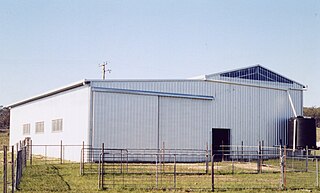Coordinates: 30°01′19″S138°02′49″E / 30.022°S 138.047°E

A geographic coordinate system is a coordinate system that enables every location on Earth to be specified by a set of numbers, letters or symbols. The coordinates are often chosen such that one of the numbers represents a vertical position and two or three of the numbers represent a horizontal position; alternatively, a geographic position may be expressed in a combined three-dimensional Cartesian vector. A common choice of coordinates is latitude, longitude and elevation. To specify a location on a plane requires a map projection.
Contents
Witchelina Station is a pastoral lease that has operated as a sheep station and cattle station but is now a nature reserve in South Australia.
A pastoral lease is an arrangement used in both Australia and New Zealand where Crown land is leased by government generally for the purpose of grazing on rangelands.

A sheep station is a large property in Australia or New Zealand whose main activity is the raising of sheep for their wool and meat. In Australia, sheep stations are usually in the south-east or south-west of the country. In New Zealand the Merinos are usually in the high country of the South Island. These properties may be thousands of square kilometres in size and run low stocking rates to be able to sustainably provide enough feed and water for the stock.

In Australia, a cattle station is a large farm, whose main activity is the rearing of cattle; the owner of a cattle station is called a grazier. The largest cattle station in the world is Anna Creek Station in South Australia, Australia.
The property is situated approximately 72 kilometres (45 mi) north west of Leigh Creek and 664 kilometres (413 mi) north of Adelaide. The country is made up of gibber plains, red river gum and coolibah woodlands, bluebush shrubland, saltbush plains and acacia dunefields. [1]

Eucalyptus cladocalyx, commonly known as sugar gum, is a species of eucalypt tree found in the Australian state of South Australia. It is found naturally in three distinct populations - in the Flinders Ranges, Eyre Peninsula and on Kangaroo Island.

Chenopodium is a genus of numerous species of perennial or annual herbaceous flowering plants known as the goosefoots, which occur almost anywhere in the world. It is placed in the family Amaranthaceae in the APG II system; older classification systems, notably the widely used Cronquist system, separate it and its relatives as Chenopodiaceae, but this leaves the rest of the Amaranthaceae polyphyletic. However, among the Amaranthaceae, the genus Chenopodium is the namesake member of the subfamily Chenopodioideae.

Atriplex is a plant genus of 250–300 species, known by the common names of saltbush and orache. It belongs to the subfamily Chenopodioideae of the family Amaranthaceae s.l.. The genus is quite variable and widely distributed. It includes many desert and seashore plants and halophytes, as well as plants of moist environments. The generic name originated in Latin and was applied by Pliny the Elder to the edible oraches. The name saltbush derives from the fact that the plants retain salt in their leaves; they are able to grow in areas affected by soil salination.
The traditional owners of the area are the Adnyamathanha and Arabunna peoples, Witchelina straddles of the boundary of both the groups traditional lands. [1] The property was first established as a sheep station by John Ragless in 1873. [2]

The Adnyamathanha are a contemporary Indigenous Australian people from the Flinders Ranges, South Australia, formed as an aggregate of several distinct peoples. Strictly speaking the ethnonym Adnyamathanha was an alternative name for the Wailpi. Adnyamathanha is also often used as the name of their traditional language, although the language is more commonly called "yura ngarwala" by Adnyamathanha people themselves.
John Ragless' sons, Frederick and Richard, left Witchelina in 1882 with 2,500 sheep and three station hands to open up a property east of Lake Callabonna, after some poor seasons the brothers abandoned the run in 1886. [3]
In 1915 the property was carrying a flock of approximately 4,000 sheep. [4] The Ragless brothers placed Witchelina on the market in 1916, at this time it occupied an area of 485 square miles (1,256 km2) with a 10-room homestead, a 20-stand shearing shed and a complete boundary fence. [5] The property was acquired by Sidney Kidman in partnership with Lewis and Pearce. [6]

Shearing sheds are large sheds located on sheep stations to accommodate large scale sheep shearing activities.

Sir Sidney Kidman was an Australian pastoralist who owned or co-owned large areas of land in Australia in his lifetime.
Following a heat wave in 1932 the station manager, Mr. Gourlay, trapped an estimated 100,000 rabbits, including 5,000 in a single night. [7]
In 1949 the area had good rains although several miles of boundary fence at Witcherina were washed away. [8] Kidman estates disposed of Witchelina, Mount Nor' West, Myrtle Springs and Ediacra stations with a combined area of over 2,000 square miles (5,180 km2) in 1950. The purchasers were A. S. Toll, E. G. and J. L. Boynthon who had established the Myrtle Springs Pastoral company. [9]
The 4,219 square kilometres (1,629 sq mi) property was on the market in 2009. [10] The property boasts a stone two storey homestead, a three bedroom managers house, a ten-room shearers quarters, a six stand stone shearing shed and significant shedding around the holding. [10] The property is rated to carry either 6,600 head of cattle or 33,000 sheep. [10]
In 2010 the property was purchased by Nature Foundation SA with two-thirds of the funds provided by a Federal Government grant via the Caring for Our Country program, with strong assistance from some private donors and State Government land purchase funds. [11] The station was reported as being the state's largest private nature reserve [11] forming "a vital habitat link for Lake Torrens into the Northern Territory." [1]





